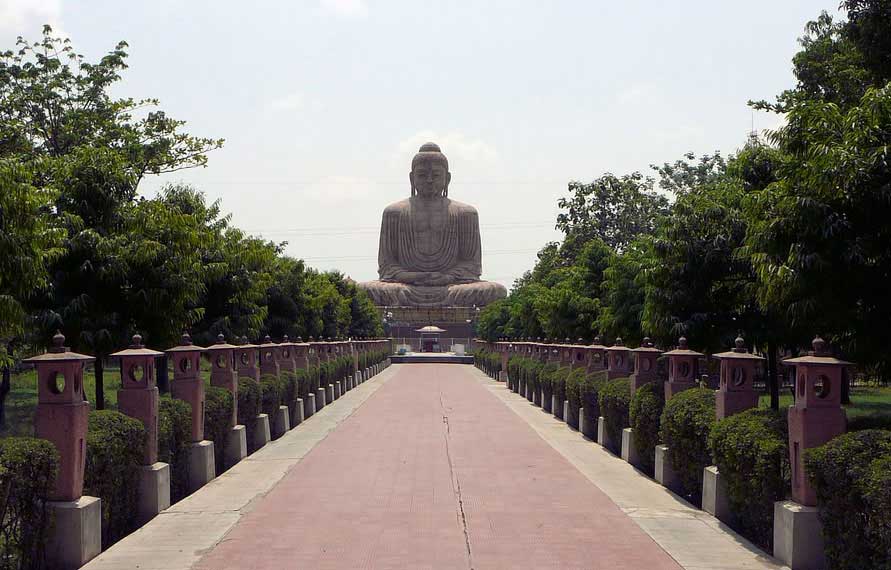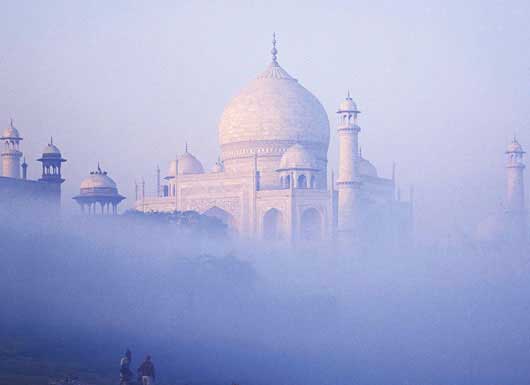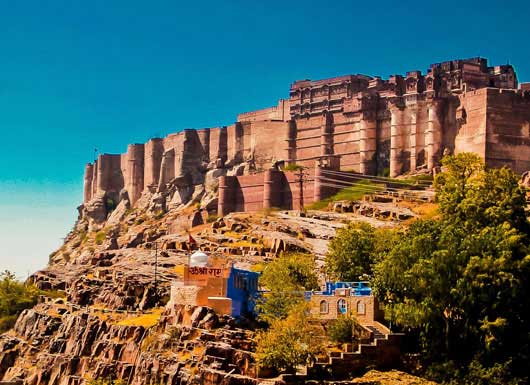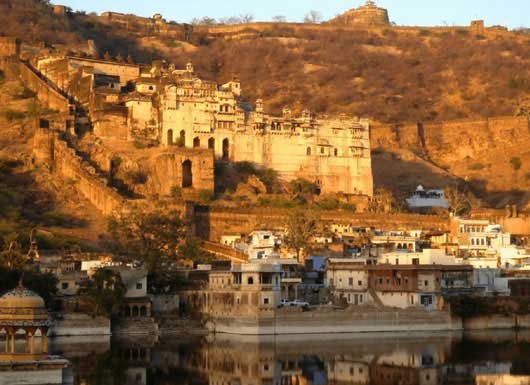Golden Triangle Tour with Ganges and Bodhgaya
Golden Triangle Tour with Ganges and Bodhgaya
Package Duration: 9 Nights and 10 Days
Places Covered: Delhi – Jaipur – Agra – Varanasi – Bodhgaya – Patna -Delhi
Tour Overview
One of the most popular tour packages for India is a visit to cities falling in the golden triangle and in this tour we have combined the ancient city of Varanasi and the place where Budhha achieved enlightenment – The Bodhgaya. So here is what a line description of each city that will offer you - Delhi will offer a potpourri of everything, Agra will take you back in the Mughal times, Jaipur will offer you a sneak-peak into the erstwhile Rajputana royalty; Varanasi will enlighten your religious spirits ; Sarnath, where Lord Buddha preached his first sermon after his enlightenment; The Bodhi Tree at Bodhgaya, under which Buddha attained enlightenment; Rajgir, the site of the first Buddhist Council after the Buddha’s nirvana; Nalanda, believed to be the oldest university in the world.
Highlights:
- Food walk in Old Delhi
- Visit of magnificent Taj Mahal
- Elephant ride at Amber Fort Jaipur
- Visit to Mahabodhi tree at Gaya
- A visit Nalanda – the oldest university
Detailed Itinerary
Day 1 : Arrive Delhi
Arrive in Delhi today and get transferred in a private vehicle to your hotel where accommodation is held from 1400 hrs. Check-in and spend the rest of the day to explore the bustling national capital. Overnight in the hotel.
Delhi offers a harmonious blend of architecture and history. From remnants of the Mughal empire and British Raj to contemporary India, you can experience it all in the capital. The city is sure to charm you with its eclectic mix of the old and new – from magnificent monuments to bustling Old Delhi markets and stunning high rises.
Day 2 : A day in Delhi
Full day excursion to Old and New Delhi, exploring the medieval and pre-modern faces of the historic capital of India personified by the Jama Masjid and Chandni Chowk (closed on Sundays). Take a food walk in the Chandni Chowk market. In Afternoon visit Humayun’s Tomb and Qutub Minar. Overnight in the hotel.
Jama Masjid is a mosque in Old Delhi, constructed in 1650–56 by the Mughal emperor Shah Jahān, a noted patron of Islamic architecture whose most famous work is the Taj Mahal, in Agra.
This vibrant market came to existence when the fifth Mughal Emperor, Shah Jahan, shifted his capital from Agra to Shahjahanabad, now Old Delhi, in the mid 17th century. While Chandni Chowk or the moonlit square no longer bears the magnificence of the bygone era, its importance in the annals of Delhi will never be lost.
The food walk in Old Delhi is a great experience to and the best way to see and taste Old Delhi. The dishes one can savor in Old Delhi Food Walk are large, thick and juicy jalebis, glistening with ghee; Aloo chaat crisp fried potato cutlets dunked in a melange of chutneys and smattered with onions and spices ; varieties of stuffed paranthas potato, onion, cottage cheese, cauliflower, radish, dry fruits and many more….
Humanyun’s Tomb was built in 1565 A.D. nine years after the death of Humayun, by his senior widow Bega Begam. Inside the walled enclosure the most notable features are the garden squares (chaharbagh) with pathways water channels, centrally located well proportional mausoleum topped by double dome.
Qutab Minar is a soaring, 73 m-high tower of victory, built in 1193 by Qutab-ud-din Aibak immediately after the defeat of Delhi's last Hindu kingdom. The tower has five distinct storeys, each marked by a projecting balcony
Day 3 : Drive to Jaipur
After breakfast leave for Jaipur by surface, a drive of about 6 hours. Arrive in Jaipur and check – in at the hotel. Overnight at the hotel.
An erstwhile princely state and now the capital of modern Rajasthan. Jaipur is popularly known as the “Pink City” because of the rose coloured wash that adorns most buildings in the old quarter and it is the first planned city in the country.”
Day 4 : A day in Jaipur
After breakfast visit Amber Fort, the grandest way to reach Amber is on an elephant back. Later we proceed to visit the City Palace and Observatory. And we also stop for some photos from across the road of Hawa Mahal – the Palace of Winds. In evening attend aarti or a prayer ceremony at Birla Mandir. Overnight in the hotel.
The City Palace reflects Rajput, Mughal and European architectural styles. The Palace has been designed according to a 'grid style' and houses various structures such as, 'Chandra Mahal', 'Mubarak Mahal', 'Diwan-I-Khas' and the 'Govind Dev Ji Temple. The walls and gates are ornately designed to Mughal style, with various murals, lattice and mirrors adorning them from sides.
The Jaipur observatory is by far the most elaborate and complete of Jai Singh’s all other Observatories. The observatory occupies a plot of land just outside the City Palace.
Jaipur’s most photographed landmark, the Hawa Mahal is an extraordinary pink-painted delicately honeycombed hive that rises a dizzying five storeys. It was constructed in 1799 by Maharaja Sawai Pratap Singh to enable ladies of the royal household to watch the life and processions of the city.
The Birla Temple, of Jaipur is built of pure white marble, whose interiors contain, beautifully sculpted idols of Lord Vishnu and Goddess Lakshmi, as well as other Hindu Gods. Commonly considered a true work of art, this temple forms a wonderful backdrop to witness a traditional ceremony.An Aarti represents the elements of fire, earth, water and air as well as the senses, the priest has a tray with a diya (lamp), offerings of food, water, flowers, incense and a small bell.
Day 5 : Drive to Agra, en-route visit Fatehpur Sikri
After breakfast drive to Agra, en – route stop for visiting the celebrated medieval Mughal city of Fatehpur Sikri. A drive of about 7 hours, arrive and check – in at the hotel. In the afternoon proceed to visit the Moonlight Garden. Overnight at the hotel.
Known to exist since prehistoric times, Agra came into full flower during the 16th and 17th centuries as one of the four capitals of Mughal dynasty. It was in Agra that the artistic excellence of the Mughals reached its zenith at a time that coincided with the political high water mark of their vast and expanding empire.
The history of Fatehpur Sikri dates back to the Mughal era in the 16th century. . Lost and abandoned, Fatehpur Sikri stands like a proud maiden showing off her beauty even as an air of melancholy surrounds it. The rich sand stone walls echo the tales of poignancy and erstwhile glory.
The Mehtab Bagh or the moonlight garden, was the last of the eleven Mughal-built gardens along the Yamuna river opposite to the Taj Mahal and the Agra Fort. Built during the period 1631- 1635 A.D., Mehtab Bagh literally means “a moonlit pleasure garden”.
Day 6 : Train to Varanasi (Onboard the Train)
After breakfast proceed to visit the Taj Mahal (closed on Fridays) , Agra Fort and Itmad Ud Daulah. In The evening drive to Tundla Railway Station for train Poorva Express leaving at 2020 hrs for Mughal Sarai (Varanasi). Onboard the train.
The Taj Mahal is an enormous mausoleum complex commissioned in 1632 by the Mughal emperor Shah Jahan to house the remains of his beloved wife. Constructed over a 20-year period on the southern bank of the Yamuna River in Agra, the famed complex is one of the most outstanding examples of Mughal architecture, which combined Indian, Persian and Islamic influences.
Agra Fort was begun by Akbar between 1565 and 1573. It is situated on the west bank of the Yamuna River, about 2km upstream from the Taj Mahal. Akbar built the fort of sandstone; his grandson Shah Jahan, the builder of the Taj Mahal, constructed palaces of white marble within the fort itself.
Do you know that the Taj Mahal was not the first or only monument in marble in Agra? Baby Taj or Itimad-ud-Daulah is a tomb that was built by mother of Shah Jahan. It has a very delicate architectural beauty. The marble lattice structures in this monument are the highlight. You can find exotic Persian styled gardens around the tomb.
Day 7 : Arrive in Varanasi
Arrive in Mughal Sarai Railway Station, transfer to Varanasi city. After wash and change leave for a day-trip to Sarnath (Sarnath museum is closed on all Fridays), a religious Buddhist site. In the afternoon city tour of Varanasi covering - Alamgir Mosque or Beni Madhav Ka Darera, Dasaswamedh Ghat and The Bharat Mata Temple. Evening we will visit the banks of Ganges for Ganga Aarti. Overnight stay in the Hotel
Buddha came to Sarnath to preach his message of the middle way to nirvana after he achieved enlightenment at Bodhgaya, and gave his famous first sermon here.
In the 3rd century BC, Emperor Ashoka had magnificent stupas and monasteries erected here, as well as an engraved pillar. When Chinese traveller Xuan Zang dropped by in AD 640, Sarnath boasted a 100m-high stupa and 1500 monks living in large monasteries. However, soon after, Buddhism went into decline and, when Muslim invaders sacked the city in the late 12th century, Sarnath disappeared altogether. It was ‘rediscovered’ by British archaeologists in 1835.
Assi Ghat is where pilgrims pay homage to Lord Shiva by worshipping a huge lingam situated under a peepal tree. This ghat is a lively space, rippling in chaos and commotion and one that vividly captures the ancientness of Kashi.
Ganga Aarti is a ceremony to thank and praise the river". A group of young saints dressed up with silky saffron and white robes conduct this ceremony. Each pandit or saint takes up a specific spot in the Ghat and start the ritual by offering flowers to the river. The ritual includes many oil lamps like snake hood lamp which are waved in a synced motion. Conch shells are blown during the ceremony too. Yak tail fans and peacock feather fans are also waved during the ceremony. The priests end the ceremony by pouring a bowl of water into the river.
Day 8 : Drive to Bodhgaya
In the early morning, enjoy boat ride across the river Ganges. Visit the numerous temples alongside river Ganga and get a closer view of Hinduism being in Varanasi. Observe the daily life of the natives. Take a walk in the narrow street of Varanasi (Old Varanasi). After visits leave for Bodhgaya by surface, a journey of about 8hrs. Arrive and check-in at the hotel. Overnight at the hotel.
Sunrise boat ride on Ganga in Varanasi is a memorable experience and not to be missed. It gives a glimpse of morning life along the ghats in Varanasi. If you are lucky you can see stunning views of sun rising in the eastern horizon.
These boats are slow moving ones with oars. Each boat has a boat man and his assistant. They move very slowly and help you to see stunning sun rise over the horizon with Ganga in the foreground, the panoramic views of ghats and the morning life on ghats closely.
The crucible of Buddhism, Bodhgaya was where Prince Siddhartha attained enlightenment beneath a bodhi tree 2600 years ago and became Buddha (the 'Awakened One'). In terms of blessedness, this tiny temple town is to Buddhists what Mecca is to Muslims. Unsurprisingly, it attracts thousands of pilgrims from around the world every year, who come for prayer, study and meditation.
Day 9 : A day in Bodhgaya
After breakfast proceed for visit of Mahabodhi Temple and Bodhi tree. Rest of the day to explore the town on your own. Overnight at the hotel.
The magnificent Unesco World Heritage–listed Mahabodhi Temple, marking the hallowed ground where Buddha attained enlightenment and formulated his philosophy of life, forms the spiritual heart of Bodhgaya. Built in the 6th century AD atop the site of a temple erected by Emperor Ashoka almost 800 years earlier, it was razed by foreign invaders in the 11th century, and subsequently underwent several major restorations. Topped by a 50m pyramidal spire, the inner sanctum of the ornate structure houses a 10th-century, 2m-high gilded image of a seated Buddha. Amazingly, four of the original sculpted stone railings surrounding the temple, dating from the Sunga period (184–72 BC), have survived amid the replicas. Others are now housed inside the archaeological museum.
Pilgrims and visitors from all walks of life and religions come to worship or just soak up the atmosphere of this sacred place. An enthralling way to start or finish the day is to stroll around the inside of the perimeter of the temple compound (in an auspicious clockwise pattern) and watch a sea of maroon and yellow dip and rise, while Tibetan monks perform endless prostrations on their prayer boards. There’s a less atmospheric Meditation Park for those seeking extra solitude within the temple grounds.
Undoubtedly, the most sacred fig tree ever to grace the Earth was the Bodhi Tree at Bodhgaya, under which Prince Siddhartha, the founder of Buddhism, achieved enlightenment. Buddha was said to have stared unblinkingly at the tree in an awed gesture of gratitude and wonder after his enlightenment. Today, pilgrims and tourists alike flock here to pray and meditate at the most important of Buddhism’s four holiest sites.
Known as Sri Maha Bodhi, the original tree was paid special attention by Ashoka, a mighty Indian emperor who ruled most of the subcontinent from 269 to 232 BC, a century or two after Buddha’s believed death. His wife, Tissarakkhā, wasn’t such a fan of the tree and in a fit of jealousy and rage, caused the original Bodhi Tree’s death by poisonous thorns shortly after becoming queen. Thankfully, before its death, one of the tree’s saplings was carried off to Anuradhapura in Sri Lanka by Sanghamitta (Ashoka’s daughter), where it continues to flourish. A cutting was later carried back to Bodhgaya and planted where the original once stood. The red sandstone slab between the tree and the adjacent Mahabodhi Temple was placed by Ashoka to mark the spot of Buddha’s enlightenment – it’s referred to as the Vajrasan (Diamond Throne).
Day 10 : Drive to Patna (en-route visit Rajgir & Nalanda) then flight to Delhi and departure
After breakfast leave for Patna by surface, en-route visit the Rajgir and Nalanda. After visits drive to Patna Airport to catch flight to Delhi leaving at 1750hrs and arriving at 1940hrs. Arrive and connect to your flight back home.
Rajgir is the ancient capital of Magadha kings. The Buddha often visited Rajagriha to retreat at the Jivkamaravana monastery, preaching and meditating on the Gridhakuta Hill. The disciples of the Buddha built many structures here. Rajgir is also sacred to Jains as Lord Mahavira studied and meditated here. The first Buddhist Council was held here after the Buddha’s nirvana.
Nalanda is believed to be the oldest university in the world. Founded in the 5th century BC, it became a renowned centre of Buddhist and Jain learning. Hieun Tsang, the Chinese traveller, spent several years here in the 7th century AD. Nalanda Archaeological Museum has a magnificent collection of Pali and Mauryan statues, bronze and manuscripts.
Nalanda Mahavihara an institute for the study of Pali literature houses rare Buddhist manuscripts. Though Buddha visited Nalanda several times during his lifetime, this famous centre of Buddhist learning shot to fame much later, during 5th – 12th centuries. The Chinese scholar and traveller Hiuen Tsang stayed here in the 7th century, and has left an elaborate description of the excellence, and purity of monastic life practised here. About 2,000 teachers and 10,000 students from all over the Buddhist world, lived and studied in this international university.
Travel Route
Customized Tours Booking?
This Tour can be customized according to your travel needs & requirement.
Book Now









